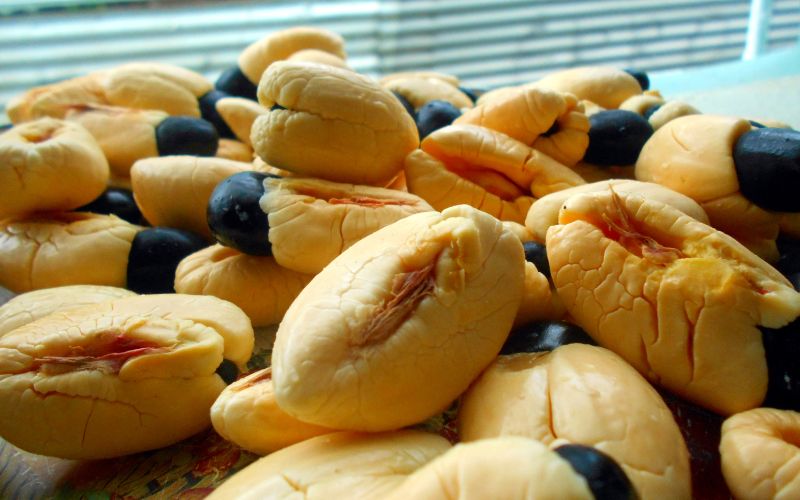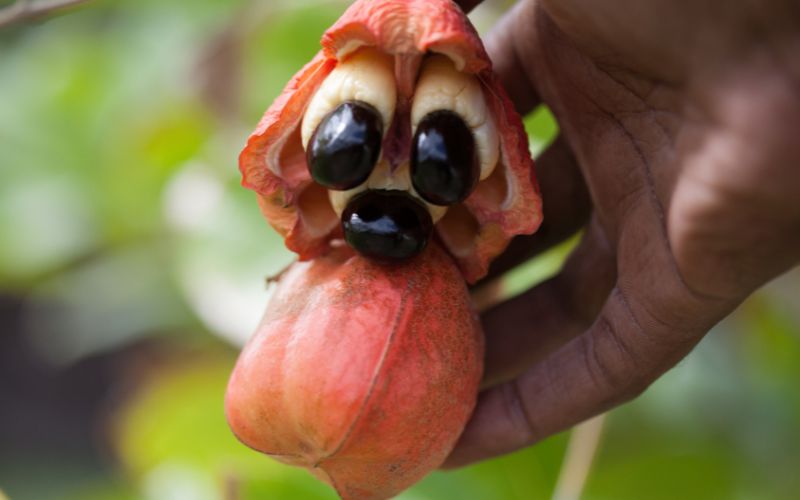The ackee fruit is an unusual-looking fruit that is commonly found in Caribbean cuisine. Despite being poisonous when unripe, it offers numerous health benefits when cooked. Let’s delve into the details about this fascinating fruit!
1 What is Ackee Fruit?
Ackee, with the scientific name Blighia sapida, belongs to the Sapindaceae family, which also includes lychee and longan. The ackee tree has a broad canopy and can grow up to 10 meters tall.
The fruit undergoes a unique color transformation as it ripens, changing from green to bright red and then to yellow-orange. When ripe, the fruit splits open to reveal large black seeds surrounded by soft, spongy, white or yellow arils.
Ackee trees thrive in tropical and subtropical climates, particularly in the Caribbean region. The fruit is deeply rooted in the culture of Jamaica, where it is famously paired with salted fish in a traditional dish.
 Ackee Fruit
Ackee Fruit
2 Nutritional Value of Ackee Fruit
Ackee fruit is an excellent source of dietary fiber, which promotes healthy digestion by stimulating bowel movements and enhancing digestive health. Additionally, fiber helps prevent common digestive issues such as bloating, constipation, colitis, and cramps.
This exotic fruit is also rich in vitamin C, a powerful antioxidant that helps reduce the risk of atherosclerosis and protect against blood vessel damage. Furthermore, the presence of vitamin C in ackee fruit contributes to combating anemia.
Ackee fruit boasts an impressive nutritional profile, containing essential minerals like iron, calcium, magnesium, phosphorus, and potassium, as well as beneficial fatty acids such as stearic acid, oleic acid, and linoleic acid.
 Nutritional Value of Ackee Fruit
Nutritional Value of Ackee Fruit
3 Is Ackee Fruit Poisonous?
Despite its unassuming appearance, the ackee fruit harbors a deadly toxin called hypoglycin A, which can cause abdominal pain, vomiting, and hypoglycemia if consumed unripe. In severe cases, where the body absorbs a significant amount of hypoglycin A, it may exceed the body’s ability to excrete it, leading to excessive vomiting, seizures, coma, and even death.
However, properly cooking the fruit renders it safe to eat, transforming the flesh into an appealing yellow-butter color with a creamy, exotic flavor. Jamaicans often prepare ackee with salted fish, creating a delicious and unique culinary experience.
 Is Ackee Fruit Poisonous?
Is Ackee Fruit Poisonous?
4 Precautions When Consuming Ackee Fruit
To ensure a safe and enjoyable experience with ackee fruit, keep the following precautions in mind:
-
Consume only fully ripe ackee fruit with well-developed seeds.
-
During preparation, remove the seeds, peel, and discard unripe fruits. Use only the yellow or white arils.
-
Purchase ackee from reputable sources to ensure the fruit’s safety.
-
If you experience any adverse symptoms after consuming ackee, seek medical attention immediately.
 Precautions When Consuming Ackee Fruit
Precautions When Consuming Ackee Fruit
In conclusion, ackee fruit is a unique and nutritious addition to any meal, but it is crucial to exercise caution and consume only ripe fruit to avoid potential health risks. Enjoy this Caribbean delicacy safely and responsibly!






































